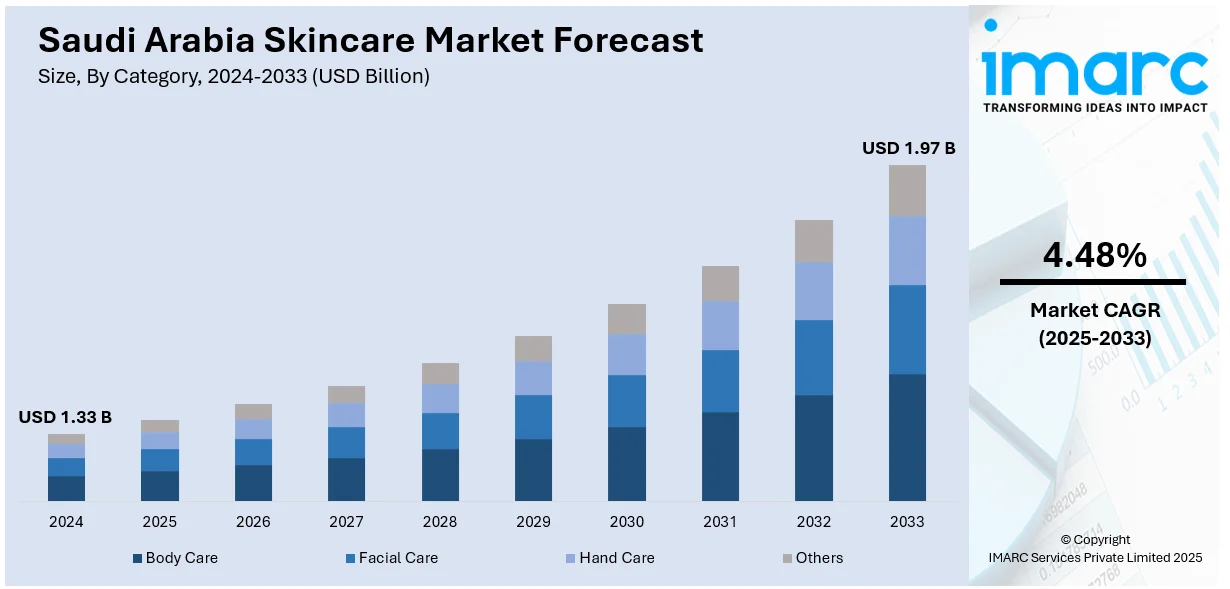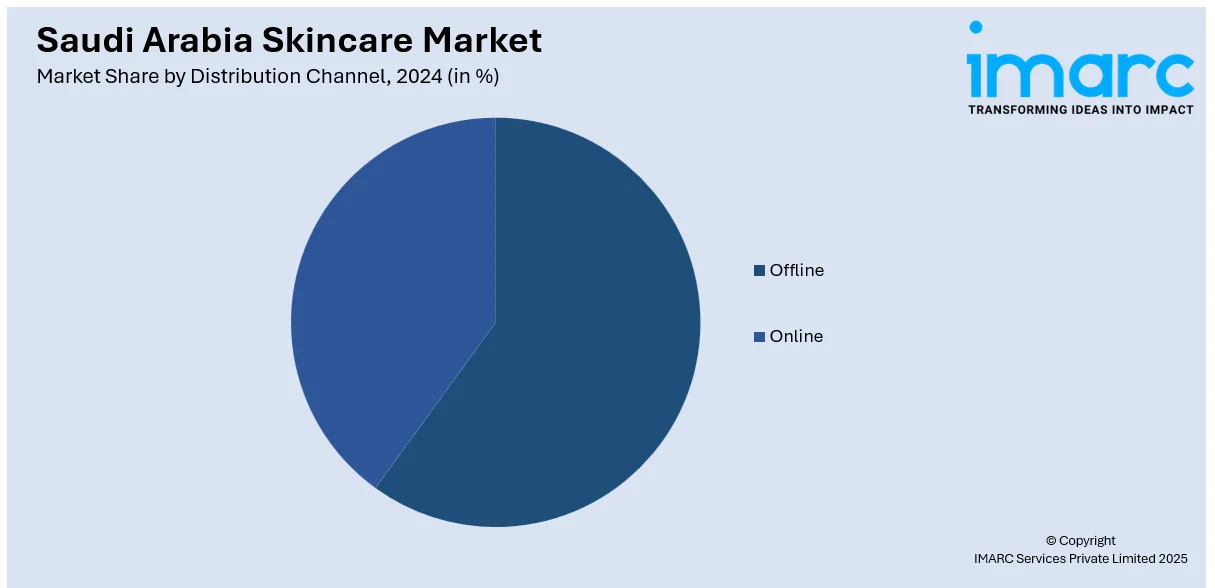
Saudi Arabia Skincare Market Size, Share, Trends and Forecast by Category, Ingredient Type, Gender, Distribution Channel, and Region, 2025-2033
Saudi Arabia Skincare Market Overview:
The Saudi Arabia skincare market size reached USD 1.33 Billion in 2024. Looking forward, IMARC Group expects the market to reach USD 1.97 Billion by 2033, exhibiting a growth rate (CAGR) of 4.48% during 2025-2033. The market is growing rapidly, driven by rising consumer awareness, demand for targeted solutions, and the emergence of local brands. International product launches and global retail entries are expanding access, while personalized, science-backed formulas gain popularity among beauty-conscious, digitally engaged consumers.
|
Report Attribute
|
Key Statistics
|
|---|---|
|
Base Year
|
2024 |
|
Forecast Years
|
2025-2033
|
|
Historical Years
|
2019-2024
|
| Market Size in 2024 | USD 1.33 Billion |
| Market Forecast in 2033 | USD 1.97 Billion |
| Market Growth Rate 2025-2033 | 4.48% |
Saudi Arabia Skincare Market Trends:
Focus on Targeted Skincare Solutions
Saudi Arabia’s skincare market is increasingly shaped by consumer demand for personalized and targeted products that address specific skin concerns. Brands are responding by launching formulas tailored to regional skin profiles, such as those combating hyperpigmentation, dryness, and uneven skin tone. With growing awareness around skin health, consumers are seeking solutions rooted in dermatological science and visible results. Campaigns that focus on confidence, self-expression, and cultural relevance are helping global brands connect more deeply with local audiences. In July 2024, Nivea introduced its Luminous630 Even Skin Tone range in Saudi Arabia, targeting common issues like uneven skin tone and stretch marks. The campaign not only showcased product benefits but also focused on empowering women through skincare. By offering a dermatologically developed formula tailored to Saudi consumers, Nivea strengthened its brand trust and expanded its influence in the region. This trend toward condition-specific skincare reflects the broader shift in consumer behavior, where effectiveness and inclusivity play a vital role in purchasing decisions. It is also encouraging innovation among both international and regional players, as brands now prioritize clinically proven, concern-specific solutions that go beyond traditional beauty marketing and instead resonate with real skincare needs.

Saudi Brands Entering Global Platforms
A growing trend in Saudi Arabia’s skincare market is the emergence of homegrown beauty brands stepping onto international stages. These brands, often founded by influencers and entrepreneurs with deep cultural insight, are blending traditional beauty values with modern product innovation. They reflect a new wave of Saudi creativity that resonates both locally and abroad. With an emphasis on inclusivity, clean ingredients, and natural radiance, these labels are contributing to a stronger national beauty identity and gaining recognition in major global markets. In July 2024, Saudi skincare and beauty brand Moonglaze, founded by Yara Alnamlah, launched at Selfridges in London. As the first Saudi brand to debut at the prestigious store, it marked a breakthrough moment for the country’s beauty industry on a global scale. This expansion highlighted the international appeal of Saudi skincare values and product aesthetics. By offering highlighters, blushes, and skincare that cater to diverse skin tones, Moonglaze positioned itself as a symbol of cultural pride and global competitiveness. The brand’s international success reflects a broader trend of Saudi entrepreneurship in skincare, paving the way for more regional players to explore global opportunities while reinforcing Saudi Arabia’s growing footprint in the beauty and skincare industry.
Saudi Arabia Skincare Market Segmentation:
IMARC Group provides an analysis of the key trends in each segment of the market, along with forecasts at the region/country level for 2025-2033. Our report has categorized the market based on category, ingredient type, gender, and distribution channel.
Category Insights:
- Body Care
- Facial Care
- Hand Care
- Others
The report has provided a detailed breakup and analysis of the market based on the category. This includes body care, facial care, hand care, and others.
Ingredient Type Insights:
- Natural
- Chemical
A detailed breakup and analysis of the market based on the ingredient type have also been provided in the report. This includes natural and chemical.
Gender Insights:
- Male
- Female
- Unisex
A detailed breakup and analysis of the market based on the gender have also been provided in the report. This includes male, female, and unisex.
Distribution Channel Insights:

- Offline
- Online
A detailed breakup and analysis of the market based on the distribution channel have also been provided in the report. This includes offline and online.
Regional Insights:
- Northern and Central Region
- Western Region
- Eastern Region
- Southern Region
The report has also provided a comprehensive analysis of all the major regional markets, which include Northern and Central Region, Western Region, Eastern Region, and Southern Region.
Competitive Landscape:
The market research report has also provided a comprehensive analysis of the competitive landscape. Competitive analysis such as market structure, key player positioning, top winning strategies, competitive dashboard, and company evaluation quadrant has been covered in the report. Also, detailed profiles of all major companies have been provided.
Saudi Arabia Skincare Market News:
- April 2025: SGS debuted at Beautyworld Saudi Arabia, offering cosmetics compliance solutions aligned with SFDA regulations. By supporting product testing, labeling reviews, and certification, SGS strengthened regulatory access for skincare brands, enhancing safe market entry and boosting confidence in Saudi Arabia’s growing beauty sector.
- January 2025: Nice One Beauty, a Saudi-based online cosmetics retailer, debuted on the Riyadh stock exchange, raising USD 320 Million. Its 30% share price surge reflected investor confidence in the region’s skincare and beauty sector, signaling strong market momentum and expanding digital retail potential.
Saudi Arabia Skincare Market Report Coverage:
| Report Features | Details |
|---|---|
| Base Year of the Analysis | 2024 |
| Historical Period | 2019-2024 |
| Forecast Period | 2025-2033 |
| Units | Billion USD |
| Scope of the Report |
Exploration of Historical Trends and Market Outlook, Industry Catalysts and Challenges, Segment-Wise Historical and Future Market Assessment:
|
| Categories Covered | Body Care, Facial Care, Hand Care, Others |
| Ingredient Types Covered | Natural, Chemical |
| Genders Covered | Male, Female, Unisex |
| Distribution Channels Covered | Offline, Online |
| Regions Covered | Northern and Central Region, Western Region, Eastern Region, Southern Region |
| Customization Scope | 10% Free Customization |
| Post-Sale Analyst Support | 10-12 Weeks |
| Delivery Format | PDF and Excel through Email (We can also provide the editable version of the report in PPT/Word format on special request) |
Key Questions Answered in This Report:
- How has the Saudi Arabia skincare market performed so far and how will it perform in the coming years?
- What is the breakup of the Saudi Arabia skincare market on the basis of the category?
- What is the breakup of the Saudi Arabia skincare market on the basis of the ingredient type?
- What is the breakup of the Saudi Arabia skincare market on the basis of gender?
- What is the breakup of the Saudi Arabia skincare market on the basis of distribution channel?
- What is the breakup of the Saudi Arabia skincare market on the basis of region?
- What are the various stages in the value chain of the Saudi Arabia skincare market?
- What are the key driving factors and challenges in the Saudi Arabia skincare market?
- What is the structure of the Saudi Arabia skincare market and who are the key players?
- What is the degree of competition in the Saudi Arabia skincare market?
Key Benefits for Stakeholders:
- IMARC’s industry report offers a comprehensive quantitative analysis of various market segments, historical and current market trends, market forecasts, and dynamics of the Saudi Arabia skincare market from 2019-2033.
- The research report provides the latest information on the market drivers, challenges, and opportunities in the Saudi Arabia skincare market.
- Porter's five forces analysis assist stakeholders in assessing the impact of new entrants, competitive rivalry, supplier power, buyer power, and the threat of substitution. It helps stakeholders to analyze the level of competition within the Saudi Arabia skincare industry and its attractiveness.
- Competitive landscape allows stakeholders to understand their competitive environment and provides an insight into the current positions of key players in the market.
Need more help?
- Speak to our experienced analysts for insights on the current market scenarios.
- Include additional segments and countries to customize the report as per your requirement.
- Gain an unparalleled competitive advantage in your domain by understanding how to utilize the report and positively impacting your operations and revenue.
- For further assistance, please connect with our analysts.
 Request Customization
Request Customization
 Speak to an Analyst
Speak to an Analyst
 Request Brochure
Request Brochure
 Inquire Before Buying
Inquire Before Buying




.webp)




.webp)












